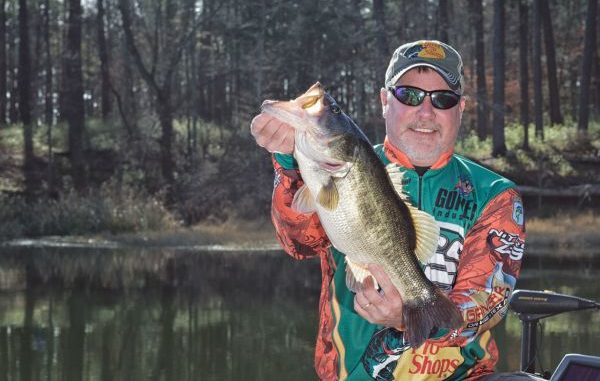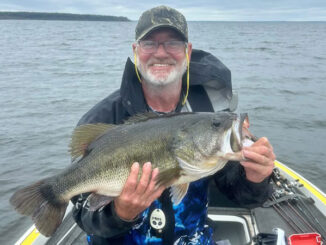
Tietje recommends Strike King Red Eye Shad to handle diverse conditions on the Bend
With a length of 65 miles, a 1,200-mile shoreline, 200,000 acres of water and a surface area of 289 square miles, it stands to reason that any lure selected as a Toledo Bend necessity better be a good one.
It better be able to work in muddy water, clear water, shallow water and deep water.
And during March, it better be able to catch pre-spawn, spawn, and post-spawn fish.
Perhaps most importantly, it better be able to catch fish around grass, shallow wood and bare banks.
For Bassmaster Elite Series angler Dennis Tietje, that lure is a lipless crankbait.
Tietje, who probably spends more time at his camp on Toledo Bend than he does at his home in Roanoke, favors a Strike King Red Eye Shad.
“For me, it’s the best way to find a school of bass in such a big lake,” Tietje said. “And the schools you locate with a Red Eye Shad are going to be active schools that you can sit on and catch 10 in a row when you find them stacked up and get them going.”
During March, Tietje likes to start at the mouth of a creek, pocket, or drain and work his way back because he knows pre-spawn bass stacked up on a point tend to be more active and easier to catch than bass locked onto a bed in the back.
“And when you set up trying to sight fish a bedding bass, you’re giving yourself a chance to catch one fish,” Tietje went on. “That’s a lot of time committed to one fish when you could be back off the points where there might be 50.”
Since crawfish are the number one food source at Toledo Bend during March, Tietje ties on a 1/2-ounce, crawfish-colored Red Eye Shad to 20-pound XPS Fluorocarbon. He sticks with heavy line since bass that are triggered to bite by reaction aren’t spending much time looking at the line.
Tietje tries two different presentations when working the points.
First, if the point is laden with grass, he fishes it over the top of the grass and allows it to flutter down just as it reaches the edge.
Second, toward the end of March when the water has had a chance to warm up, he fishes it up higher near the surface with a straight, fast retrieve.
“In both retrieves, I think the best advice I can give anybody is that bass seem to trigger on sudden changes with these lures,” Tietje said. “It seems like whenever you drastically change speeds is when they’ll smash it.”
Take a situation when your lipless crankbaits bogs down in grass. A sharp rip of your rod tip is often all it takes to clear grass off your bait, and that sudden darting forward is often what triggers a bass to bite.
If there was any condition that makes Tietje’s Red Eye Shad even more productive, it’s clear water.
“When you look at some of the best spots for a lipless crankbait – places like Hurricane Creek, Indian Mounds, Housen, and Pirates Cove – they’re all in the lower, clearer part of the lake,” Tietje said. “That’s not to say it won’t work up north, because it will as long as you look for the clearest water.”
A side note that Tietje made about lipless crankbaits are their ability to catch the smallest to the largest size bass and everything in between.
Toledo Bend may have more water than just about any other lake in the United States, but that doesn’t mean anglers have to try to fish all of it. Settle in on the points leading to spawning pockets and start casting a lipless crankbait.
You’re likely to find yourself surprised at how many bass in such a big lake can stack up in such a small place.
Editor’s Note: This is the final article in a weeklong series by Chris Ginn on effective bass baits in March for locations around the state. Previously, he covered Caney Lake, Red River, Delacroix to Bayou Black and Lake D’Arbonne.


